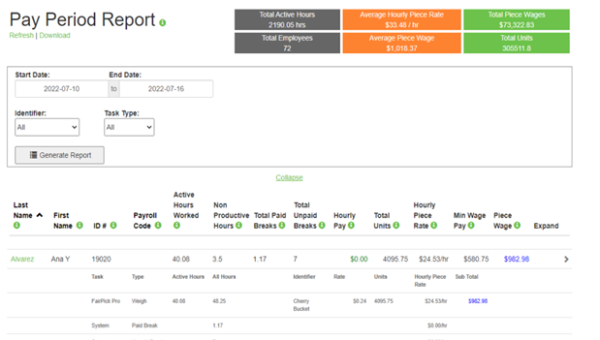Background
In today’s fast-paced work environment, labor costs are a crucial aspect of business management. In agricultural settings, as in all business settings, overtime pay increases the cost of labor, increasing the input needed to get produce to market. The complication of determining whether a worker should be paid overtime is complicated even more when that worker is paid by the piece. Implementing effective piece rate tracking systems and accurately monitoring overtime can significantly impact a company’s profitability.
Piece Work
Piece work is a compensation system where employees are paid based on the number of items they produce, tasks they complete or the weight of produce picked, rather than the hours they work. Piecework pay motivates employees, as it directly ties their earnings to their productivity.
However, tracking piece work can be challenging. It requires a robust system that accurately records the number of pieces an employee produces, or the weight of the produce picked. Without full transparency and records easily accessible to both the employer and the employee, there may be disputes.
Overtime Pay and Its Implications
Overtime pay is additional compensation given to employees who work beyond regular working hours. Federally, the Fair Labor Standards Act (FLSA) requires employers to pay nonexempt employees at least one and a half times their regular rate for hours worked beyond 40 in a workweek. Traditionally, under the FLSA, agricultural employers have not had to pay their workers overtime. https://www.dol.gov/agencies/whd/fact-sheets/12-flsa-agriculture
In the past few years, however, states like California, Washington, Oregon, and Minnesota have passed laws requiring overtime pay for agricultural workers. Employers in these states must pay all agricultural workers overtime once these workers pass the state overtime threshold. While most states have a weekly threshold, California also has a daily overtime threshold.
Accurate tracking of overtime hours is essential for several reasons to ensure employees are compensated fairly. It also helps businesses manage labor costs and comply with labor laws.
Implementing Effective Labor Tracking Systems
Here are some strategies for and benefits of implementing effective labor tracking systems:
- STRATEGY: Use Technology – Leveraging technology greatly simplifies labor tracking.
- Time-tracking software automatically records the hours employees work, including overtime.
- For piece work, specialized software can track the number of items produced or the weight picked and the hours over which it was produced, providing a piece rate hourly wage.
- This same technology can also warn the employer when employees are approaching the overtime threshold, allowing the employer to reduce overtime costs.
BENEFITS: More accurate records, less human-related data input errors, time saved doing manual entry.
- STRATEGY: Pay Transparency – When the employer commits to transparency, the employer has better employer-employee relations. When employees can see what they picked and can easily understand how their pay is calculated, they trust their employer more.
- Time-tracking software provides employees with receipts after a weigh, at the end of the day, and at the end of the entire pay period.
- Receipts provided at multiple points by automated systems show employers and employees know how much was picked and how much will be paid.
- Easy-to-access records give employers a way to avoid employee disputes.
- Pay transparency is paramount if employers are ever subject to compliance audits.
BENEFITS: Better employer-employee relations due to trust. Better employee retention. Fewer employee complaints.
ADDITIONAL BENEFITS:
Time and Money Savings: An effective labor tracking system, especially if automated, will save employers time, money, and headaches.
- Some automated systems may not require an additional employee to ensure workers do not cheat the system.
- Totaling end-of-day receipts or punch cards becomes a thing of the past when pieces and/or hours are tracked automatically.
Conclusion
Effective labor tracking is key to managing piece work and overtime pay. By leveraging technology and maintaining transparency, businesses can ensure fair compensation, boost employee motivation, and enhance productivity making it a win-win for both employers and employees.
2nd Sight can help agricultural employers with labor tracking solutions. Send us a message at



